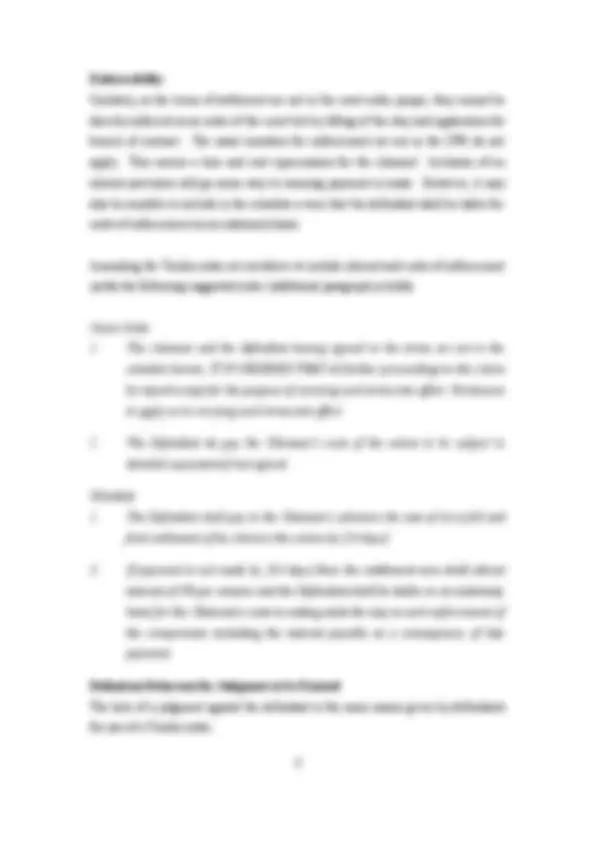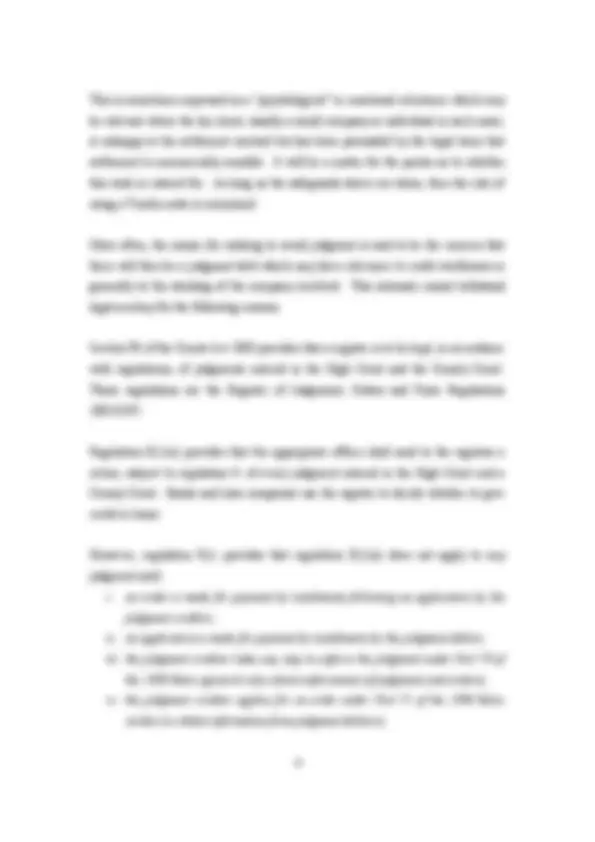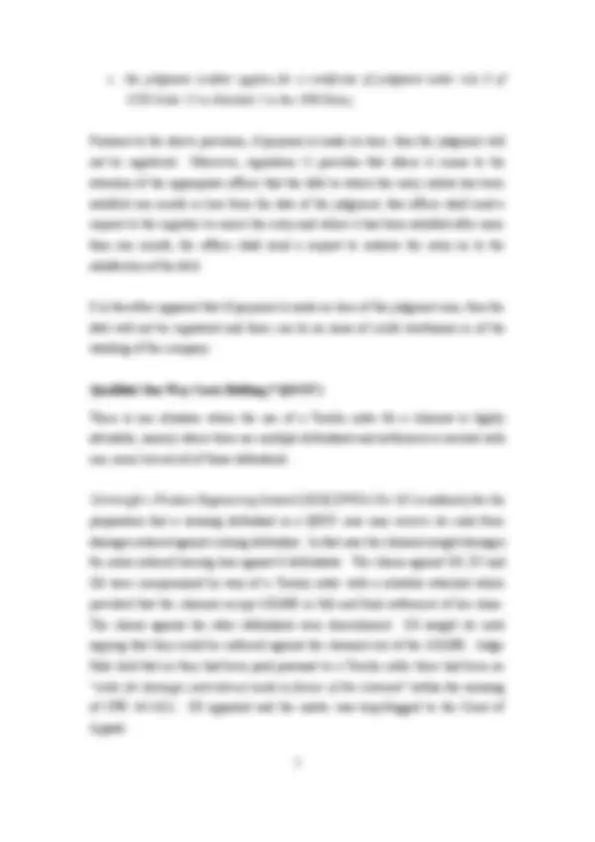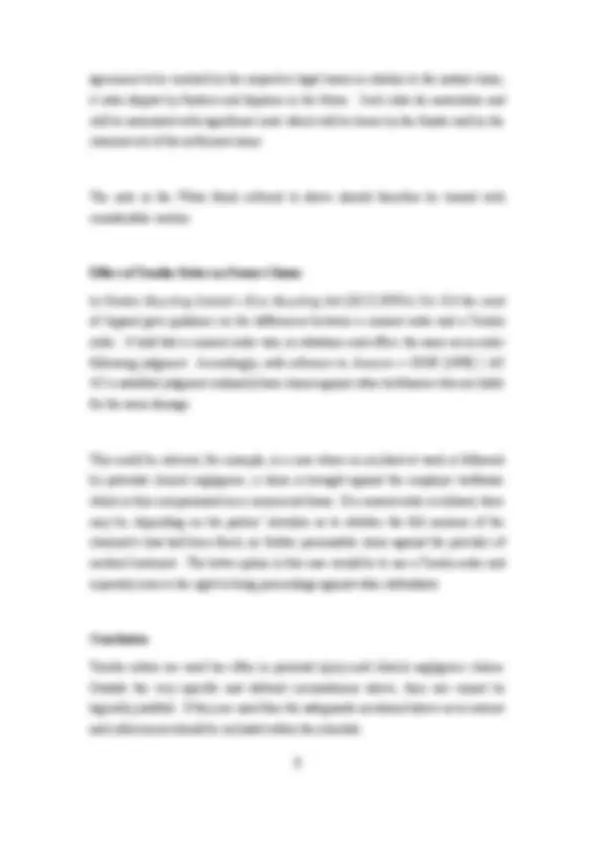







Study with the several resources on Docsity

Earn points by helping other students or get them with a premium plan


Prepare for your exams
Study with the several resources on Docsity

Earn points to download
Earn points by helping other students or get them with a premium plan
Community
Ask the community for help and clear up your study doubts
Discover the best universities in your country according to Docsity users
Free resources
Download our free guides on studying techniques, anxiety management strategies, and thesis advice from Docsity tutors
The use of Tomlin orders in personal injury and clinical negligence litigation. It covers the reasons for using a Tomlin order, its validity, advantages, and necessary safeguards. The document also explains the process of obtaining a Tomlin order and its differences from a consent order.
Typology: Study notes
1 / 9

This page cannot be seen from the preview
Don't miss anything!






Tomlin Orders: When and How Should They be Used in Personal Injury and Clinical Negligence Litigation? Justin Valentine Published on 24th February 2021
There is, in general, no need to use a Tomlin order where all that is required is an order that one party shall pay money to another. However, one party may request that the terms of settlement be recorded in a Tomlin order rather than an ordinary consent order. This article reviews the reasons that may be suggested for using a Tomlin order, examines the validity of such reasons, sets out the advantages and disadvantages of such a procedural step and discusses the safeguards which should be employed if a Tomlin order is used.
After trial in which the claimant has been successful, there will be judgment for the claimant and an order for costs in the claimant’s favour. An ordinary consent order follows this format, is entitled “Consent Order” and, in its simplest form could be as follows:
A Tomlin order is a form of consent order which avoids the entering of judgment. It takes its name from a Practice Note issued by Tomlin J in 1927 though it was in use well before that date.
A Tomlin order is in two parts. The first part is the court order proper which stays the proceedings on agreed terms contained in the second part, the schedule. The schedule records the terms of settlement agreed between the parties and amounts to a binding contract. The contract set out in the second part cannot be directly enforced as an order of the court but requires an application to carry the terms into effect in the case of breach, ie failure to pay the agreed damages. In its simplest form in the personal
injury/clinical negligence context it is headed “Tomlin Order” and is in the following format:
Court Order
1. The claimant and the defendant having agreed to the terms set out in the schedule hereto, it is ordered that all further proceedings in this claim be stayed except for the purpose of carrying such terms into effect. Permission to _apply as to carrying such terms into effect.
Schedule
1. The Defendant shall pay to the Claimant’s solicitors the sum of £x in full and final settlement of his claim in this action by [14 days].
The “Permission to apply” provision at paragraph 1 of the court order is the mechanism by which breach, ie failure to pay, can be enforced.
The order for costs, paragraph 2, must be in the court order proper otherwise the court will not be able to exercise the judicial function of the detailed assessment process.
Absence of Judgment As is apparent, there is no judgment in the sum of £x in a Tomlin order. This has a number of important implications.
Interest In the absence of a judgment the settlement sum will not attract statutory interest (currently 8% per annum). Although late payment of damages is rare, it can happen. Accordingly, this is not a theoretical but an actual risk which may prejudice a claimant. This can be remedied by the inclusion of an interest provision in the schedule.
This is sometimes expressed as a “psychological” or emotional reluctance which may be relevant where the lay client, usually a small company or individual in such cases, is unhappy at the settlement reached but has been persuaded by the legal team that settlement is commercially sensible. It will be a matter for the parties as to whether this wish is catered for. As long as the safeguards above are taken, then the risk of using a Tomlin order is minimised.
More often, the reason for wishing to avoid judgment is said to be the concern that there will then be a judgment debt which may have relevance to credit worthiness or generally to the standing of the company involved. This rationale cannot withstand legal scrutiny for the following reasons.
Section 98 of the Courts Act 2003 provides that a register is to be kept, in accordance with regulations, of judgments entered in the High Court and the County Court. Those regulations are the Register of Judgments, Orders and Fines Regulations 2005/3595.
Regulation 8(1)(a) provides that the appropriate officer shall send to the registrar a return, subject to regulation 9, of every judgment entered in the High Court and a County Court. Banks and loan companies use the register to decide whether to give credit or loans.
However, regulation 9(c) provides that regulation 8(1)(a) does not apply to any judgment until: i. an order is made for payment by instalments following an application by the judgment creditor; ii. an application is made for payment by instalments by the judgment debtor; iii. the judgment creditor takes any step to enforce the judgment under Part 70 of the 1998 Rules (general rules about enforcement of judgments and orders); iv. the judgment creditor applies for an order under Part 71 of the 1998 Rules (orders to obtain information from judgment debtors);
v. the judgment creditor applies for a certificate of judgment under rule 8 of CCR Order 22 in Schedule 2 to the 1998 Rules;
Pursuant to the above provision, if payment is made on time, then the judgment will not be registered. Moreover, regulation 11 provides that where it comes to the attention of the appropriate officer that the debt to which the entry relates has been satisfied one month or less from the date of the judgment, that officer shall send a request to the registrar to cancel the entry and where it has been satisfied after more than one month, the officer shall send a request to endorse the entry as to the satisfaction of the debt.
It is therefore apparent that if payment is made on time of the judgment sum, then the debt will not be registered and there can be no issue of credit worthiness or of the standing of the company.
Qualified One-Way Costs Shifting (“QOCS”)
There is one situation where the use of a Tomlin order for a claimant is highly advisable, namely where there are multiple defendants and settlement is reached with one, some but not all of those defendants.
Cartwright v Venduct Engineering Limited [2018] EWCA Civ 165 is authority for the proposition that a winning defendant in a QOCS case may recover its costs from damages ordered against a losing defendant. In that case the claimant sought damages for noise-induced hearing loss against 6 defendants. The claims against D4, D5 and D6 were compromised by way of a Tomlin order with a schedule attached which provided that the claimant accept £20,000 in full and final settlement of his claim. The claims against the other defendants were discontinued. D3 sought its costs arguing that they could be enforced against the claimant out of the £20,000. Judge Hale held that as they had been paid pursuant to a Tomlin order there had been no “ order for damages and interest made in favour of the claimant ” within the meaning of CPR 44.14(1). D3 appealed and the matter was leap-frogged to the Court of Appeal.
device for settling quantum on a conditional basis ”. The same would hold for a defendant seeking variation of periodical payments. The latter may arise, for example, where a defendant has a certain scepticism that a claimant will move to, or stay within, his own private accommodation as opposed to statutory-funded residential care.
The terms of CPR 41.8 and the Practice Direction will not permit a variable periodical payments order where the dates on which and the amount of increase or decrease is uncertain. Such order was sought in AA v CC and MIB [2013] EWHC 3679 (QB) where Swift J held that the court did not have power under CPR 41 to make an order for periodical payments which would start and end on dates which were uncertain. Further, the court found that the Damages (Variation of Periodical Payments) Order 2005 did not assist the parties in the circumstances. Nevertheless, a solution presented itself in the form of making this part of the agreement subject to a Tomlin order. Swift J was then content to approve the Tomlin order.
However, as is made clear in a useful discussion of Tomlin orders by Warby J in Zenith Logistics Services (UK) Ltd and others v Keates [2020] 1 WLR 2982 the schedule to a Tomlin order merely records the terms of settlement agreed between the parties. Therefore, the court cannot “approve” those terms for the purposes of CPR 21.10, ie where the claimant is a child or protected party. Approval is an exercise of judicial function representing an external check on the propriety of the settlement; Dunhill v Burgin (Nos 1 & 2) [2014] UKSC 18; [2014] 1 WLR 933.
Accordingly, a Tomlin order is not an appropriate mechanism where a party lacks capacity (as he did in AA v CC and MIB ).
In any event, attempts to sidestep the clear provisions of periodical payment legislation, both procedural and substantive, are unwise. Although it may allow
agreement to be reached by the respective legal teams in relation to the instant claim, it risks dispute by funders and deputies in the future. Such risks do materialise and will be associated with significant costs which will be borne by the funder and by the claimant out of the settlement sums.
The note in the White Book referred to above should therefore be treated with considerable caution.
Effect of Tomlin Order on Future Claims
In Vanden Recycling Limited v Kras Recycling Lt d [2017] EWCA Civ 354 the court of Appeal gave guidance on the differences between a consent order and a Tomlin order. It held that a consent order was, in substance and effect, the same as an order following judgment. Accordingly, with reference to Jameson v CEGB [1998] 1 AC 455 a satisfied judgment ordinarily bars claims against other tortfeasors who are liable for the same damage.
This could be relevant, for example, in a case where an accident at work is followed by potential clinical negligence, a claim is brought against the employer tortfeasor which is then compromised on a commercial basis. If a consent order is utilised, there may be, depending on the parties’ intention as to whether the full measure of the claimant’s loss had been fixed, no further permissible claim against the provider of medical treatment. The better option in this case would be to use a Tomlin order and expressly reserve the right to bring proceedings against other defendants.
Conclusion
Tomlin orders are used too often in personal injury and clinical negligence claims. Outside the very specific and defined circumstances above, their use cannot be logically justified. If they are used then the safeguards mentioned above as to interest and enforcement should be included within the schedule.